ITALY 2008
Day 4
SATURDAY, May 10th
RAVENNA
We got up at 6:00 am and did some packing before having
breakfast at 7:00. My wife lost a
filling out of one of her molars. We finished packing and called a taxi to take
us to the Avis rental office. We had
requested a small Mercedes like we had in Germany but they only had a 4 door
Opal. Last year in advance of our
trip to Germany, we reserved a VW to be picked up our last day in Cologne.
The morning we went to get it, they hesitated for a few minutes and said
that they were sorry but they couldn’t get us VW, but would we accept a
Mercedes at the same price. Of
course, we had to have a big discussion about that !!! ha, ha.
It was a small Mercedes and was wonderful.
So we had ordered one for this trip, only to get the Opal.
The saleslady had told us that the Opal was a diesel, but later when we
stopped to get gas we found it wasn’t and used regular gas.
It also had a rough shifting pattern for an automatic – we almost got
whip lash everything it changed gears. Later
in the day, as we neared Florence, the air conditioning started making a loud
noise so we had to turn it off. It
also lacked power when we started up the mountain to our villa.
That car was quite a come down from the wonderful Mercedes, Avis rented
us in 2007 in Germany.
We had driven in France,
the Germany autobahn, and Switzerland
without any difficulty. In fact, I
had said that driving on the German autobahn was much easier and safer than
driving on the Washington, DC beltway.
So now we would have our first experience driving in Italy.
The cancellation of our flight by Iberia Airline which
necessitated our starting our trip three days before we had planned was really a
blessing – we wouldn’t have been able to visit Padua.
We enjoyed every minute in Padua and could have stayed a few more days.
We did see a lot in two days – The Cathedral, St. Anthonia, St.
Giustina, St. Nicolo, Church of the Hermits, and Scrovengi with the wonderful
Giotto frescos as well at the University and the Palazzo della Ragione.
plus a concert. The old town was a lot of fun, and we would love to go
back someday.
Our final destination on this day was our villa in Montoloro
above Florence. It was only 140 miles south to Florence from Padua, but we had
planned a side trip in order to visit Ravenna.
Ravenna was 119 miles southeast of Padua.
It would then be 118 miles to our villa.
So going to Ravenna was a 100 miles side trip. I had taken an art history
class at the Smithsonian Institution and one of the sessions was devoted to the
mosaic works in the Ravenna churches. The
instructor, Dr. Judy Feldman, said that Ravenna would be well worth the side
trip- and it was. Thank you, Judy!
We were struck by how flat the land was as we approached
Ravenna. Ravenna is south of Venice
on the Adriatic Sea. There were a
lot of beaches in the area. Our GPS
worked fine, but we made several wrong turns getting into Ravenna.
The Italians don’t mark their roads as well as the German.
The origin of Ravenna is unclear, but evidence shows that the
Romans acquired it 89 BC. Caesar
gathered troops there in 49 BC. Ravenna
offered a harbor that could accommodate 250 ships during the Imperial Age.
During the Roman Empire, Ravenna reached its height of splendor and
wealth and became the capital of the Roman Empire. Odoacer,
the German chieftain who proclaimed himself king of the Roman Empire, seized
Ravenna when the Roman Empire fell in 476. After
three years Theodoric, king of the Ostrogoths, killed Odoacer.
In 518 Justinian became emperor of the East and conquered Ravenna and
ruled it from Constantinople. He
persecuted the Arians (those who believed that Jesus is not God by nature but by
adoption – condemned at the Council at Nicea in 325) and forced Theodoric to
do the same. Because Ravenna
spent so much of its history under the Eastern rule, its greatest art treasurers
show much Byzantine influence. It is
a city of mosaics.
 Our first stop was St. Vitale
church.
We found the church parking lot without much trouble. The church was
named after St. Vitale, a martyr who died in Bologna in the 3rd
century. The Church was begun in 527 and consecrated in 548.
Our first stop was St. Vitale
church.
We found the church parking lot without much trouble. The church was
named after St. Vitale, a martyr who died in Bologna in the 3rd
century. The Church was begun in 527 and consecrated in 548.
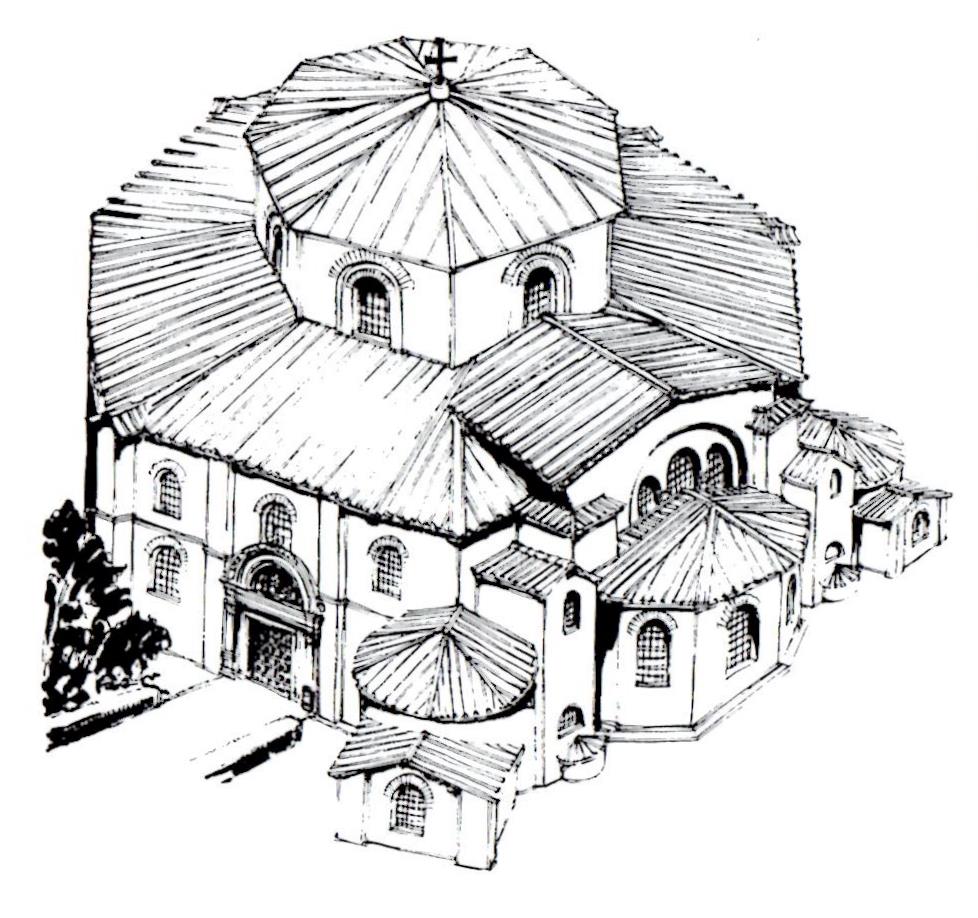
It
is an extraordinary example of Byzantine architecture with influences of Rome
and Ravenna. The apse is
polygonal unlike other churches of Western tradition.
There is an octagonal dome which measures 52.2 feet in diameter.
On the inside are 8 large pillars with 8 niches on which the dome is
placed.
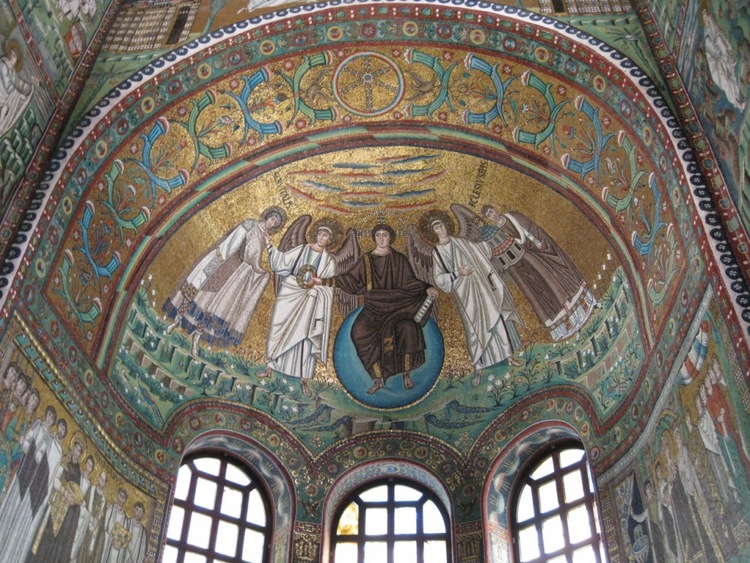
The mosaics are truly breathtaking.
The apse ceiling features the enthroned figure of Christ flanked by two
white clad archangels. On the right is St. Vitalis and on the left Bishop
Ecclesius (527) who was the bishop who began building the church.
The side wall mosaics are remarkable.

On the left side is the “procession of Justinian”. Justinian, who
holds a bread basket, is in procession with soldiers, clergy, dignitaries and
Bishop Maximian.
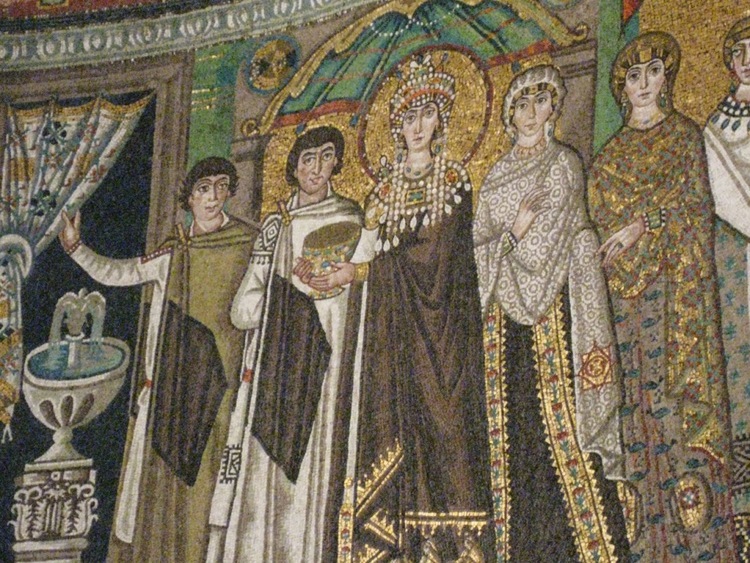
On the opposite
side is the “procession of Theodora”, Justinian’s wife, and her train.
Many other mosaics depict stories and personalities of the Bible. We
could have stayed all day there, but we had other wonderful experiences awaiting
us.
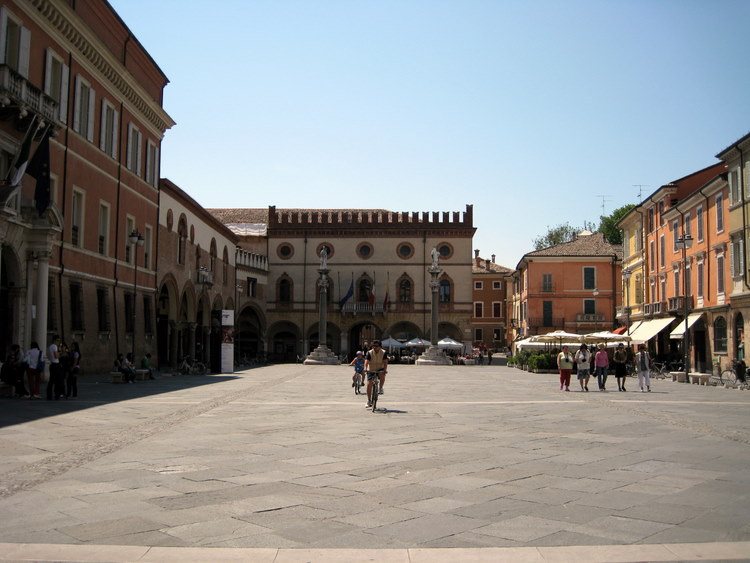
After leaving St. Vitale, we stopped at a nice sidewalk café.
My wife had risotto, and I had thin sliced beef and balsamic vinegar.
Both were very good. After
walking through Plazzo Poplo, which was a huge square area surrounded by
colorful buildings, we came to Dante’s Tomb.
 It was build in 1921, six hundred years after he died.
The tomb is in a small building. Over
the tomb is a hanging light that is continuously fed with oil offered by
Florence. Dante had been banished
from Florence in 1302 over his political views.
Long after his death, Florence wanted him back, but Ravenna wouldn’t
release him.
It was build in 1921, six hundred years after he died.
The tomb is in a small building. Over
the tomb is a hanging light that is continuously fed with oil offered by
Florence. Dante had been banished
from Florence in 1302 over his political views.
Long after his death, Florence wanted him back, but Ravenna wouldn’t
release him.
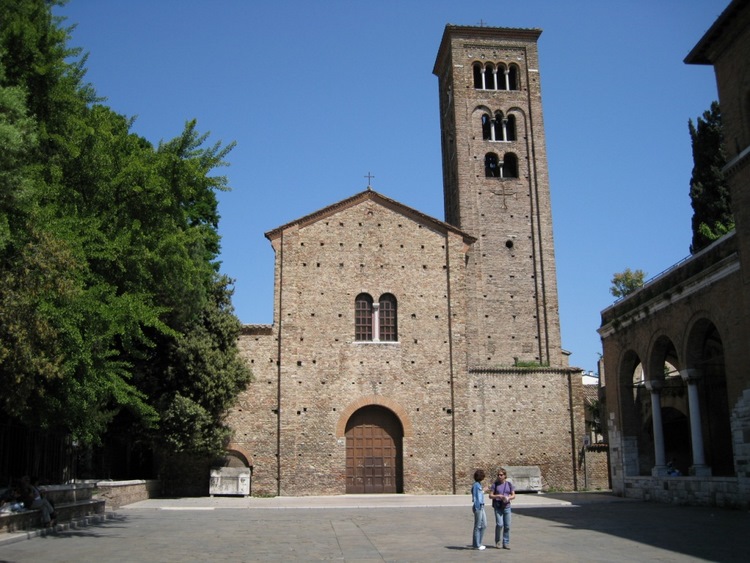
Next door to the tomb
was St. Francis Church where Dante’s funeral took place in 1321, but it was
closed for construction.

Walking a little further we came to
St. Apollinare Nuovo which
was a 6th century basilica. St.
Apollinare , was an archbishop from Antioch who established Christianity first
in Classe, outside of Ravenna and
then in Ravenna itself. We would see
St. Appollinare in Classe next. There
had been a controversy about where his bones are, but it was decided in favor of
Classe. St. Apollinare Nuovo had
been erected by the Arians and dedicated to Christ by Theodoric. For a while the
church had been deconsecrated by the Catholics because of Arian Heresy.

The church nave was one big room.
The entire top of the wall were covered with mosaics. Next
to the ceiling were scenes from the life of Christ.
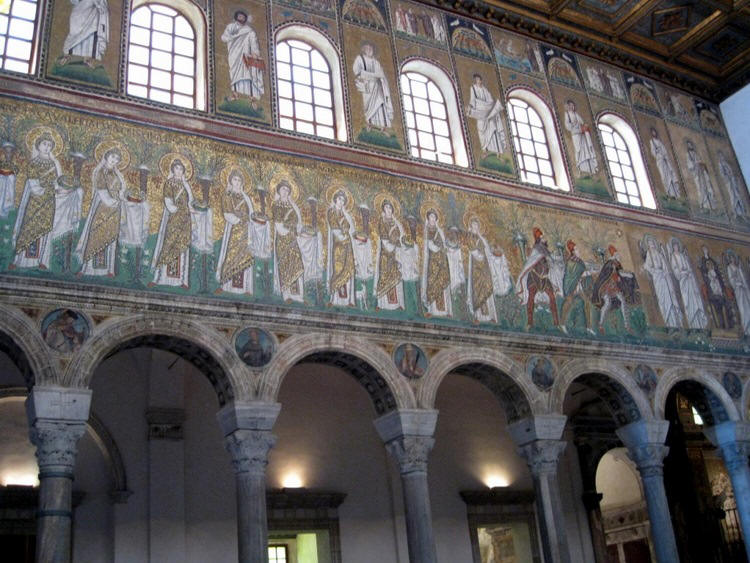 On the left wall was a procession of 22 virgins of the Byzantine period. They
were all richly dressed. The three wise men were in the procession and had on
red Phrygian caps. The
Phrygian cap
is a sort of cross between a close-fitting cap and a hood which was worn by the
ancient Greeks.
On the left wall was a procession of 22 virgins of the Byzantine period. They
were all richly dressed. The three wise men were in the procession and had on
red Phrygian caps. The
Phrygian cap
is a sort of cross between a close-fitting cap and a hood which was worn by the
ancient Greeks.
 The right wall had a procession of 26 martyrs toward the
Christ. At the end of the procession
was a palace which had formerly held a mosaic of Theodoric on horseback, but he
and his court had been painted over (blacked out) except for a few hands on the
columns. This was done because
Theodoric was a supporter of the Arians.
The right wall had a procession of 26 martyrs toward the
Christ. At the end of the procession
was a palace which had formerly held a mosaic of Theodoric on horseback, but he
and his court had been painted over (blacked out) except for a few hands on the
columns. This was done because
Theodoric was a supporter of the Arians.
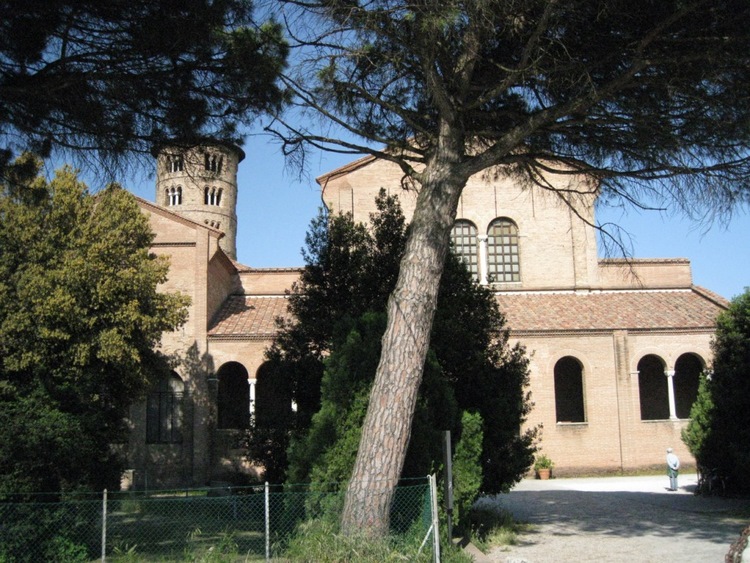
We had to retrieve our car from St. Vitale parking lot.
St. Apollinare en Classe
wasn’t
too far away although we made several wrong turns.
The church was in a beautiful
setting, sort of out in the middle of nowhere on the coast of the Adriatic Sea. It
was a large church, built in 549.

The
apse had wonderful mosaic of Apollinare standing flanked by 12 sheep .
In the background were trees and above Apollinare was a huge cross with
the head of Jesus in the center.

The
nave, like Apollinare Nuovo, was a large room with a wooden ceiling.
There are 24 interior columns of Greek veined marble. There are other
wonderful mosaics at the very top and on the sides.
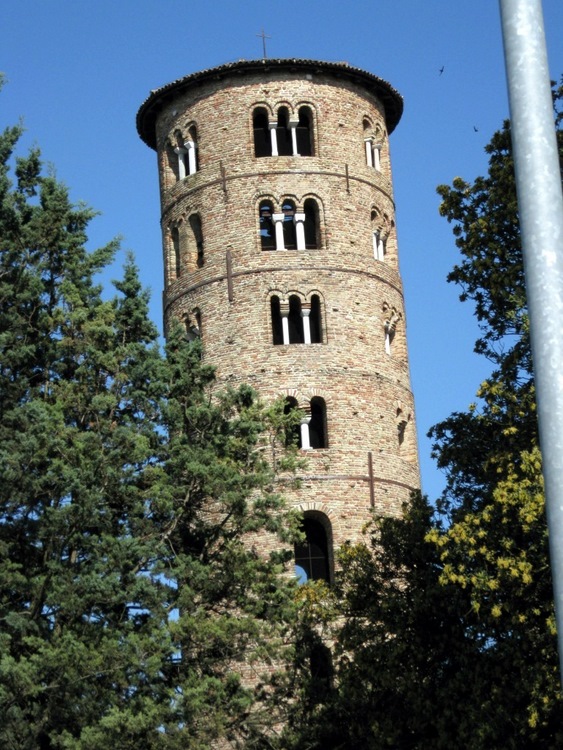
The unattached bell tower, which is 10th century, is 123 feet
high. It was spared during WWII and
used as an observation point for the Germans.
It soon became 5:00 pm and time to head towards
Monteloro.
If we had known Ravenna was going to be such a wonderful town, we would
have made some arrangements to have stayed another day.
We started to
Monteloro. Again
we made a few wrong turns but got on the right road. The GPS sure is a wonderful
devise to have. It was a two hour
drive. We stopped for gas and
bought a couple of sandwiches to eat along the way.
We went south east around Florence to the back side of the mountain at
Sieci rather than going by Fiesole. Driving
up the narrow mountain road was quite an experience.
The car lacked power and kept switching gears ..more whip lash.., it was
getting dark and the road was very curvy and narrow.
It reminded me of one of those Italian movies with a car chase on such a
road. We just prayed that we
wouldn’t meet someone coming the other way.
We finally came to Monteloro. Our GPS got us to the right turn- off for
Monteloro and the Villa but we kept going down a very narrow mountain road.
We thought that we were lost but eventually we got to the gate for the
villa. There were a lot of little
driveways and it was getting dark but we found it.
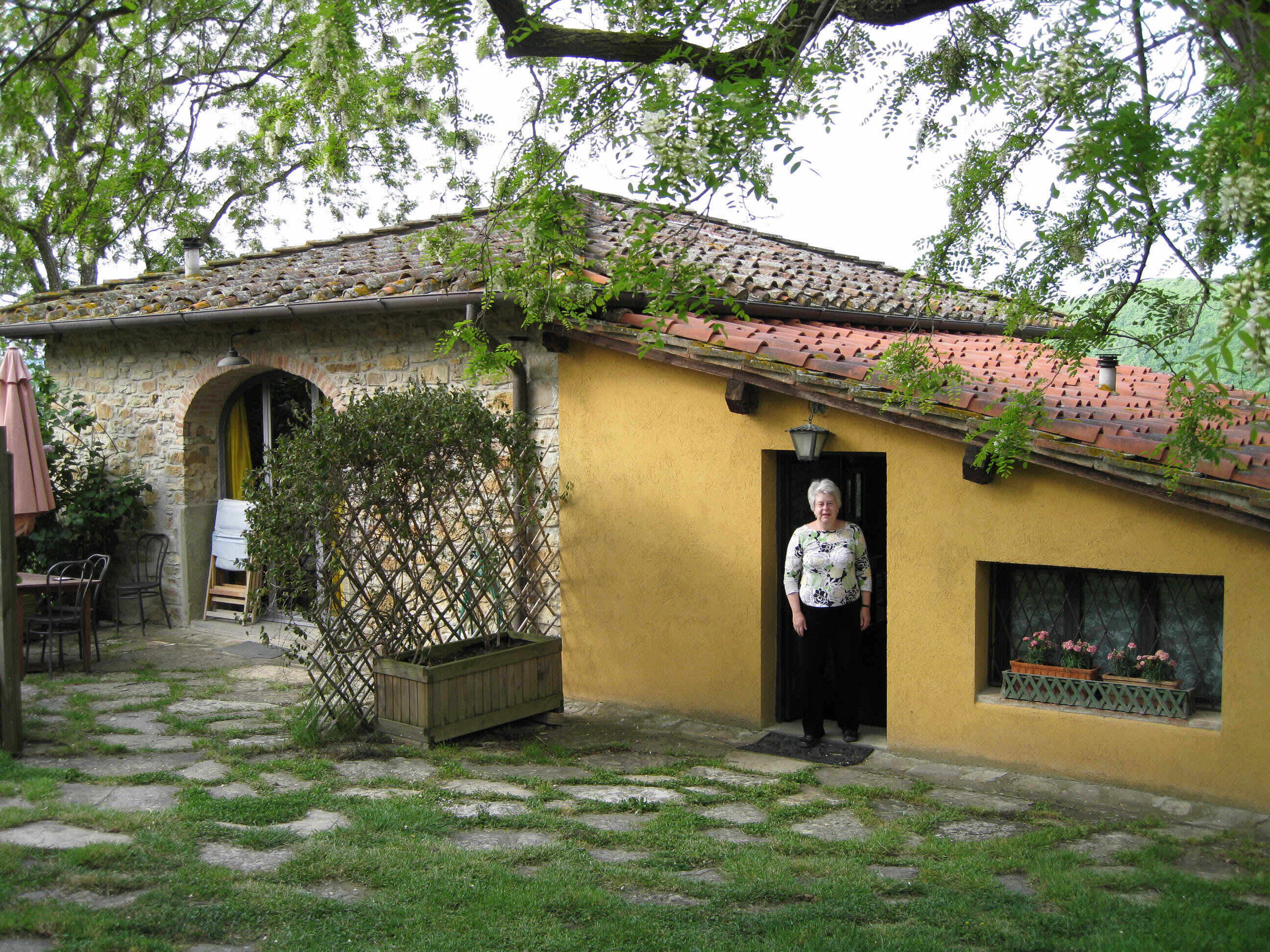 Our friends, Mike and Mary from Alexandria, Va., who would be
joining us the next day, had found this villa several years ago on the internet.
They had enjoyed their visit, and they ask us to join them for a return
visit. There was a large beautiful
stone villa with a carriage house or it may have been a toll house in front.
In that building the owners had made two apartments on the main level and
one in the basement. We were shown
both apartments and choose the one on the right.
Mike and Mary would have the one on the left. No one was staying that
week in the basem
Our friends, Mike and Mary from Alexandria, Va., who would be
joining us the next day, had found this villa several years ago on the internet.
They had enjoyed their visit, and they ask us to join them for a return
visit. There was a large beautiful
stone villa with a carriage house or it may have been a toll house in front.
In that building the owners had made two apartments on the main level and
one in the basement. We were shown
both apartments and choose the one on the right.
Mike and Mary would have the one on the left. No one was staying that
week in the basem ent apartment. Both apartments had a large living room, a well
furnished kitchen, a small dining area, a well appointed bedroom and bath.
The view from the back windows was breath taking.
It reminded us of the movie, “Under the Tuscan Sun”.
ent apartment. Both apartments had a large living room, a well
furnished kitchen, a small dining area, a well appointed bedroom and bath.
The view from the back windows was breath taking.
It reminded us of the movie, “Under the Tuscan Sun”.
Our intention has been to stop at a grocery somewhere and buy
supplies for breakfast and find some dinner, but it was too late and we were too
tired to venture out again, so we depended on the sandwiches we had had on the
road to tide us over to morning.







 It was build in 1921, six hundred years after he died.
The tomb is in a small building. Over
the tomb is a hanging light that is continuously fed with oil offered by
Florence. Dante had been banished
from Florence in 1302 over his political views.
Long after his death, Florence wanted him back, but Ravenna wouldn’t
release him.
It was build in 1921, six hundred years after he died.
The tomb is in a small building. Over
the tomb is a hanging light that is continuously fed with oil offered by
Florence. Dante had been banished
from Florence in 1302 over his political views.
Long after his death, Florence wanted him back, but Ravenna wouldn’t
release him.





 It was build in 1921, six hundred years after he died.
The tomb is in a small building. Over
the tomb is a hanging light that is continuously fed with oil offered by
Florence. Dante had been banished
from Florence in 1302 over his political views.
Long after his death, Florence wanted him back, but Ravenna wouldn’t
release him.
It was build in 1921, six hundred years after he died.
The tomb is in a small building. Over
the tomb is a hanging light that is continuously fed with oil offered by
Florence. Dante had been banished
from Florence in 1302 over his political views.
Long after his death, Florence wanted him back, but Ravenna wouldn’t
release him.



 On the left wall was a procession of 22 virgins of the Byzantine period. They
were all richly dressed. The three wise men were in the procession and had on
red Phrygian caps. The
Phrygian cap
is a sort of cross between a close-fitting cap and a hood which was worn by the
ancient Greeks.
On the left wall was a procession of 22 virgins of the Byzantine period. They
were all richly dressed. The three wise men were in the procession and had on
red Phrygian caps. The
Phrygian cap
is a sort of cross between a close-fitting cap and a hood which was worn by the
ancient Greeks.
 The right wall had a procession of 26 martyrs toward the
Christ. At the end of the procession
was a palace which had formerly held a mosaic of Theodoric on horseback, but he
and his court had been painted over (blacked out) except for a few hands on the
columns. This was done because
Theodoric was a supporter of the Arians.
The right wall had a procession of 26 martyrs toward the
Christ. At the end of the procession
was a palace which had formerly held a mosaic of Theodoric on horseback, but he
and his court had been painted over (blacked out) except for a few hands on the
columns. This was done because
Theodoric was a supporter of the Arians. 




 ent apartment. Both apartments had a large living room, a well
furnished kitchen, a small dining area, a well appointed bedroom and bath.
The view from the back windows was breath taking.
It reminded us of the movie, “Under the Tuscan Sun”.
ent apartment. Both apartments had a large living room, a well
furnished kitchen, a small dining area, a well appointed bedroom and bath.
The view from the back windows was breath taking.
It reminded us of the movie, “Under the Tuscan Sun”. 

 On the left wall was a procession of 22 virgins of the Byzantine period. They
were all richly dressed. The three wise men were in the procession and had on
red Phrygian caps. The
Phrygian cap
is a sort of cross between a close-fitting cap and a hood which was worn by the
ancient Greeks.
On the left wall was a procession of 22 virgins of the Byzantine period. They
were all richly dressed. The three wise men were in the procession and had on
red Phrygian caps. The
Phrygian cap
is a sort of cross between a close-fitting cap and a hood which was worn by the
ancient Greeks.
 The right wall had a procession of 26 martyrs toward the
Christ. At the end of the procession
was a palace which had formerly held a mosaic of Theodoric on horseback, but he
and his court had been painted over (blacked out) except for a few hands on the
columns. This was done because
Theodoric was a supporter of the Arians.
The right wall had a procession of 26 martyrs toward the
Christ. At the end of the procession
was a palace which had formerly held a mosaic of Theodoric on horseback, but he
and his court had been painted over (blacked out) except for a few hands on the
columns. This was done because
Theodoric was a supporter of the Arians. 




 ent apartment. Both apartments had a large living room, a well
furnished kitchen, a small dining area, a well appointed bedroom and bath.
The view from the back windows was breath taking.
It reminded us of the movie, “Under the Tuscan Sun”.
ent apartment. Both apartments had a large living room, a well
furnished kitchen, a small dining area, a well appointed bedroom and bath.
The view from the back windows was breath taking.
It reminded us of the movie, “Under the Tuscan Sun”. 
